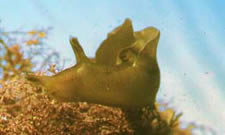
Dimdima
Online Children's Magazine from India

Dimdima
Online Children's Magazine from India



By Rani Iyer

Sitting on the rocky beach in Pondicherry, I was astonished when a huge wave deposited large brown seaweed on my feet! Imagine my surprise when I actually saw a slug on it. Hanging on to the specimen, I dashed towards the University to get it identified.
"Sea hare," said the student.
"This is a slug!" I disagreed and sought the attention of the professor.
"Sea hare," he nodded sagely.
The sea hare is a Mollusk, related to sea slugs and marine snails; and found in temperate and tropical ocean waters all over the world. The Indian species, Stylocheilus longicauda, was discovered about 175 years ago. It has been collected about 10 or 15 times, and in most cases it was found attached on the brown seaweed. It probably spends its life on floating algae in the open ocean.
It is closely related to Stylocheilus striatus, which is found throughout the tropics, often in huge numbers on sand or mud, feeding on an organic layer on the surface.
Although solitary, sea hare is both male and female. It still needs to mate to lay fertile eggs, up to 80 million apiece. Predators eat most of these eggs. When threatened by predators, some species of sea hares release a dark purple fluid, derived from a pigment in algae, in defense. Sea Hares store noxious chemicals from their algal food, in their skins, and when these chemicals are secreted, they provide a powerful defense. Sea hares can't see like we do; their simple eyes can only tell light from dark.
Sometimes, the sea hares 'invade' beaches. In New Zealand, during May 2000, sheltered coasts and estuaries were filled with sea hares. More than 400 of them were found in less than ten square meters of sand. These groups keep moving locations. Some scientists suggest that they have unusually high reproduction rates once in 11 years, which coincides with the sunspot cycle.
Last updated on :2/27/2004
EXPLORE MORE...
COMMENT ON THIS ARTICLE
Wants to share something related to this article? Please use the form below.
Dimdima is the Sanskrit word for ‘drumbeat’. In olden days, victory in battle was heralded by the beat of drums or any important news to be conveyed to the people used to be accompanied with drumbeats.
Bharatiya Vidya Bhavan
K. M Munshi Marg,
Chowpatty, Mumbai - 400 007
email : editor@dimdima.com
Bharatiya Vidya Bhavan
505, Sane Guruji Marg,
Tardeo, Mumbai - 400 034
email : promo@dimdima.com
Dimdima.com, the Children's Website of Bharatiya Vidya Bhavan launched in 2000 and came out with a Printed version of Dimdima Magazine in 2004. At present the Printed Version have more than 35,000 subscribers from India and Abroad.